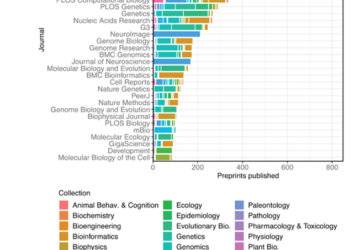The past twenty years have brought substantial consolidation to our sector. Each of today’s major scholarly publishers is the product of progressive acquisitions. And, the past decade has seen a drumbeat of acquisitions in the platforms that support scholarship and scholarly communication — from Elsevier’s acquisitions of SSRN, bepress, Mendeley, Pure, and Aries to the announcement this year that Clarivate will acquire ProQuest. Not surprisingly, there has been frequent, at times reflexive, customer opposition to acquisitions in these sectors, motivated by concerns about pricing. Here are a few powerful examples. Despite these objections, we expect there to be further announcements of mergers, acquisitions, strategic alliances, and other forms of consolidation in the days and years ahead. Which raises an important question: While consolidation is certainly in the interest of the consolidators, are there times when consolidation also works to the benefit of customers and users?
Before we get into instances of “beneficent” consolidation, we wish to declare that we do not take a romantic view of the workings and goals of commercial entities. Such organizations combine with others for any number of reasons, but they all come down to money in its many varieties: higher sales, greater pricing power, more profit, enhanced branding, and the growth of the value of the underlying assets. Customers and end-users may benefit as well from such consolidation, but those benefits are epiphenomenal. To evaluate any instance of consolidation requires great analytic care and thoughtfulness to determine who benefits beyond the shareholders. It should go without saying that the press release issued upon an acquisition should be read skeptically, but skepticism is not the same thing as comprehensive and instantaneous condemnation. If that condemnation is to come, it should follow from an analysis not only of the benefits to the shareholders but also of the benefits, if any, to the customers. Here are three customer benefits that we believe deserve at least some consideration. We welcome a discussion of these, as well as of additional forms of customer benefits, in the comments.

Benefit 1: Scale and Stability
One very good reason to favor consolidation is when it provides scale and financial stability to a specialized or niche provider. Such a specialized provider may find it a struggle, if not impossible, to sustain itself over time without such scale.
When Ex Libris/ProQuest purchased Research Professional and Pivot, each of these was a small and independent provider of funding information for academic researchers in discrete geographical sectors. By bringing them together, there can be a substantial capital investment to improve functionality and connect these standalone platforms with related services.
In the scholarly communications sector, several privately owned companies such as bepress, Aries, Atypon, and SSRN became major providers on which hundreds of publishers or libraries came to rely. When individual owners of such companies are ready to retire or address estate planning issues, these companies are often too mature to attract venture capital yet too small to attract private equity or consider an IPO. Their owners’ only choice for an exit is to sell to a strategic buyer. This has been the case for a number of the acquisitions of independently owned platform firms that major publishers have made in recent years. One can reasonably take issue with the particular configuration of a given acquisition, not to mention the number of companies coming under the ownership of a single major corporation, but one must also consider the alternatives. In such cases, alternative strategic purchasers would most likely have included the major publishing incumbents and a few other companies like Ex Libris/ProQuest and Clarivate. There was no scenario in which these companies would remain independent forever.
Another easy illustration is in the book world, where distribution remains primarily in print (about 80% of all books sold even in the U.S. are in print; the figure is higher elsewhere). Print distribution is not inherently global, making it necessary for the publisher to create marketing partnerships around the world. Let’s imagine a book publisher in Australia, which struggles to penetrate the much larger American market, who may not have the resources to build out a robust digital presence, which involves much more than getting digital files to Amazon. Consolidating that company with a publisher with a global footprint will make the publisher’s offerings available to a wider audience, and also perhaps significantly increase the royalty income due to the authors.
Benefit 2: Workflows
Users also benefit when a consolidation serves to streamline and integrate workflows. This is such an obvious benefit to end-users that it is often surprising how long it takes for some consolidations to deliver on workflow benefits.
We have seen many examples of consolidations that stand to improve user workflow. For example, following their acquisitions of various systems, both Clarivate and Elsevier have merged multiple logins to make it simpler for users to work within their ecosystems. Having the same login for Mendeley and SSRN may seem like a minor benefit in the grand scheme of things, but the time and energy saved by millions of users should not be discounted.
Another example here are the efforts that several major publishers have made in integrating preprint and version of record workflows, which rely on manuscript submission and editorial management systems. One has to hope that in purchasing Aries, perhaps the dominant editorial system, Elsevier will be able to roll out vastly improved workflows bringing SSRN and ScienceDirect closer together, certainly for its own strategic benefit but also for the benefit of authors and other researchers.
Benefit 3: Reestablish Competition
Paradoxically, consolidation may serve to increase competition, not weaken it. This happens when a particular market segment already has a dominant player, but consolidation among other, smaller organizations in the same segment can put pressure on the leading incumbent. In the research publishing area any consolidation that does not include Elsevier potentially makes it possible to compete more effectively with Elsevier. In the primary publishing landscape, this was a big part of the rationale for Wiley’s acquisition of Blackwell. In the systems and tools landscape, it is a driver of Clarivate’s acquisition of ProQuest. While many observers bemoan these actions (and the Clarivate deal has attracted the attention of regulatory agencies), it’s almost certainly the case that Elsevier would have been happier if neither of these deals took place. Consolidation, in other words, in some instances may be a useful method to offset the problem of excessive concentration in a particular industry segment.
We can imagine additional consolidations that could strengthen the competitiveness of weaker players and thereby improve market efficiency. Any consolidation of library systems providers could strengthen competition with Alma. And similarly, the acquisition of ProQuest by Clarivate stands to strengthen the combined position of Esploro and Converis, over time potentially increasing competition for Digital Commons, Pure, and Symplectic.
Consolidation is unwelcome when it serves to solidify the market position of an industry leader — for example, imagine what the landscape would look like if Elsevier bought Taylor & Francis. Such consolidation would make investment in innovation irrelevant, as there is no meaningful competition to ward off. And it is not just monopoly to be concerned about: monopsony, where there is a de facto single buyer for publications, can also stifle investment and invention. The exemplar of this is Amazon, at least in the U.S., whose market share for books exceeds 50%, making it impossible to operate a book business without Amazon’s cooperation along reasonable business terms. Amazon is not always reasonable.
Reflections
In each of the categories listed above, a consolidation provides real benefit to the customer community, in addition to whatever benefit it offers to the firms involved in the transaction. Of course, a complete analysis of an acquisition and its market impacts may find that other downsides outweigh the upsides to the customer community. Still, we believe there are cases — many more than is typically realized — when the customer community has good reason to cheer a consolidation rather than oppose it.
In what other ways can consolidations benefit a customer community? We invite you to add your thoughts here in the comments.
Discussion
14 Thoughts on "When Consolidation Provides Benefits as well as Market Power"
One does not have to be a Bolshie to recognize the downside of consolidation and the ill effects of commercial publishers dominance in many scientific fields. One need only refer to Ted Bergstrom’s extensive work on the economics of publishing.
An added shame of consolidation is that it so ties up library budgets, indexes, librarians’ minds, scholars’ emails, “quality adjudicators” ( Impact Factor, altmetrics) etc., that it forecloses on market opportunities for scholar-run journals to gain attention. Scholar-run journals are important sites for the establishment of emerging research areas and their communities. Of course, OA is a possible path for scholar-run initiatives, but after the pool of volunteer labour has been drained, OA journals must seek funding from inevitably conservative organizations and institutions.
Thanks – this is a really thought-provoking post. I get the impression that the regulators have not taken much notice of all the consolidation in the academic publishing market. Is that now changing with the examination of the Clarivate/ProQuest deal? Would the regulators step in if Elsevier tried to buy T&F?
I don’t think scholarly publishing is big or important enough to attract regulatory intervention. To paraphrase Bogie, it’s not worth a hill of beans.
Was thinking about this a bit further. Using data from this paper:
https://journals.plos.org/plosone/article?id=10.1371/journal.pone.0127502
The biggest publisher, Elsevier, has around 24% of the science papers, and 16% of the SSH papers. To use your example, T&F has around 2.9% of the total science papers and 12.4% of SSH. Even if you consider them separate markets, would regulators blink at one company going from controlling 24% of the market to 27%? Is that enough of a change to make a difference, and should 27% of a market be considered monopolistic?
Regulators will look more closely at sales, not # of papers, and on that basis the industry percentages are higher. And and while $10B is not a huge market, any deal of any size has to clear Hart-Scott-Rodino, an FTC anti-trust approval process, it’s a legal requirement to get any deal passed.
The $10B figure is from 2017 — has anyone done a more recent estimation?
If it stayed flat, Elsevier lists some £2.637B ($3.7B approx) in 2019. I’m not sure how much of that one can attribute to STM journals — the Bookseller notes that Elsevier’s Primary Research Segment “accounts for around half of its revenues” (https://www.thebookseller.com/news/elsevier-sees-profit-and-revenue-lift-1192787).
Either way, is 37% of a market considered a monopoly share and unlikely to pass muster? Is 18.5% if one limits the market to The Bookseller’s definition? The US FTC suggests that they typically do not find monopoly power to be held by any firm with less than 50% of the market, though the percentages are less important than the “significant and durable market power — that is, the long term ability to raise price or exclude competitors” of the firm, coupled with its conduct (https://www.ftc.gov/tips-advice/competition-guidance/guide-antitrust-laws/single-firm-conduct/monopolization-defined).
Primary research subscription revenues represented much less than half of Elsevier’s revenues in 2020. You can see the breakdown on page 14 of this presentation: https://www.relx.com/investors/investor-presentations/2021 Its total revenues were £2.7bn, so subscription revenues were less than £1.35bn. Elsevier’s databases and tools together with transactional revenues were bigger sources of sales than the subscription journal business.
On page 34, you can see that Elsevier published just 18% of articles in 2019, and the top four companies published just 40% of all articles – far from a monopoly or an oligopoly. The barriers to entry in publishing are also low – witness the success of MDPI.
PS: I work for Elsevier’s parent company, RELX.
Agreed with Tim on all counts. But on the regulatory question, one obvious question arising in this globalised context is often ‘whose regulators?’, and in which jurisdictions would any such suits be held? As senior tech commentators like Benedict Evans have often pointed out, anti-trust legislation in the US and the equivalent in Europe have historically had very different motors – which is of course one reason why regulatory attitudes to (e.g.) Amazon and Microsoft have differed profoundly too. The invocation of the concept of monopsony in the post is really refreshing too!
The historic ambivalence of some university libraries towards publisher consolidation (potentially workflow-positive, fiscally-negative) and the challenges this can pose for (e.g.) some of the newer Open Access initiatives in the monograph space, celebrating precisely their own absence of scale, has been an important and perhaps under-articulated schol comm theme in recent years. I well remember being told by a senior Korean university librarian some years ago how much administratively cheaper and easier it was to purchase and process $10K worth of books from one publisher, rather than $100 worth of books from 100 different imprints…a piece of anecdata from the old paywalled world, I know, but conveying at least an element of a brutal truth which will (I suspect) still apply in many institutions globally?
I was in a situation where if the publisher were not absorbed it would have gone out of business. Thus, another benefit of consolidation.
Any critical academic worth their salt would follow the efforts of people like Sir Tim Gowers and the @radicalOA initiative which show very clearly the enormous downsides to the consolidation process. 1) a lack of commitment to scholarly-led initiatives in the global commons – because they don’t make money. If they did, an even bigger company could easily stomp on them. Examples: the journal called Human Geography, which has the most radical anti-corporate stance until the new editors sold rights to Sage. 2) Ability to set high APCs for OA and still receive good flow of business from academics, now that the mainstream alternative – prestigious, legacy journals with high impact and paywalled – are beginning to be converted to OA. 3) policing of their copyright to the remaining paywalled or copyrighted material on aggregator sites and web pages is made easier by greater size/resources. Easier to request ‘final version takedowns’ from us 4) still, after such mergers, little commitment to ‘poorer’ markets in the developing world and the global South unable to pay high APCs or to subscribe. 5) Muscling in on publication initiatives like PlanS to make sure they retain a flow of resources to insure large company viability and placate shareholders is made easier by greater size. Look at this nice video from AmeliCA about PlanS . I know which system I would prefer. https://twitter.com/ariannabec/status/1088173845331075072 6) Theories of innovation suggests monopolies or near monopolies making good profits are not the ideal places for interesting and risky new initiatives. When shareholders see the company nicely coining it in, from a position of market dominance. While it might be nice to think innovation will occur amongst the small fry on the margins, they can just as easily be stomped or bought up at any time. 7) Outsourcing of production operations to the Global South, where wages are lower, is a common feature of multinationals. small academic led journals in the global commons can’t operate that model. If they did have money, wages would be fair and not driven down.
The answer to decreased competition through mergers is not ‘more mergers to restore the balance’, it is blocking and reversing mergers. If market share is not high enough to justify breaking up a company, we may be using the wrong definition of market. For example, if journals are unique products, you could say that each publisher has a monopoly to their journals. That is how they establish their pricing power.
Intregating workflows sounds good for users, but it also means that users become more reliant on the provider. Elsevier is very good at buying companiesthat provide useful services, so when they integrate workshops it becomes harder to do research independently from Elsevier. That is very bad for academics.
Consolidation can absolutely impact consumers in adverse ways. Those many ways can seem obvious. Whether they fully outweigh the benefits is a different question–often a question of which benefits. Librarians hate the “lock” on their money; but they often welcome the savings in time (fewer sign-ons for patrons to manage; fewer systems to teach students and faculty to navigate; fewer vendors to negotiate with).
And there are other considerations that Joe and Roger have not considered. Try this one: consolidations can enable start-ups. How so? Let’s take a very real example. The creators of Alexander Street Press, an innovator for its time, were able to start their operations in part through monies paid by ProQuest for Chadwyck-Healey. (The ASP founders held some equity.) The acquisition of Alexander Street Press, in turn, has made possible the start up Coherent Digital.
In other words, consolidation funds are not just a retirement option or an estate planning tool. They actually can finance new business opportunities, particularly for potential disruptors if they opt to stay in the same space and explore new modes of publishing, delivery, information creation, what have you.
Alternatively, what happens to those niche businesses that don’t find a buyer? They often just go out of business. Now you might argue that their dissolution reflects their non-competitiveness. But actually highly specialized publishers can serve niche markets that large businesses may be able “float” through synergies with other product lines or through broader market reach.
And there is a side issue here. In the academic publishing space, there are rounds of consolidation. But there is still lots of room for start ups. We know because SK keep reporting on them.
However, a more trenchant observation worth some consideration is the degree and viability of start ups in certain spaces. One area where there isn’t much in the way of consolidation–the world of university presses–also offers few if any “start ups.” How often have we read of individual UPs facing possible closure while at the same time any number of universities continue to pass on starting a UP. The spate of presses that appeared after World War II and even into the 1980s and 1990 have now seen reversal. Is the field too full? While we do have competition, do we have innovation because we don’t have an real consolidation that can allow for innovators who take their money off the table to arise? The UP universe is a good test case of what a presumably highly competitive field looks like with many small operators, largely non-integrable via consolidation, offers in terms of innovation. My own view, at a glance, is not much.



